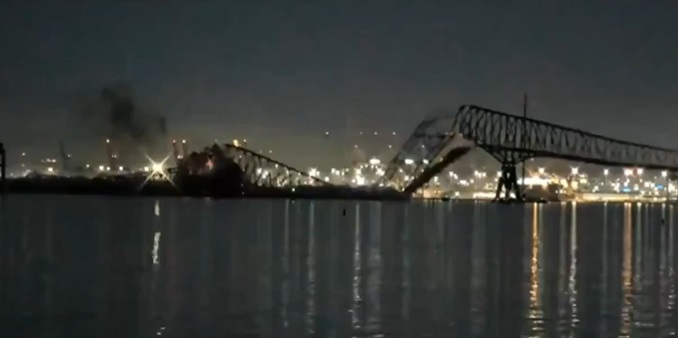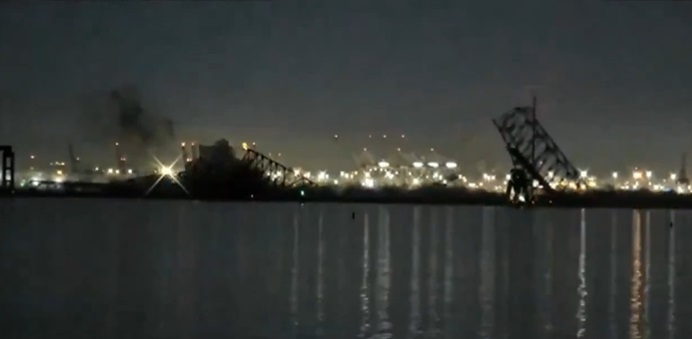The impact caused the bridge to collapse, sending cars and people plunging into the river below
The Francis Scott Key Bridge in Baltimore collapsed Tuesday morning after a 948-foot container ship lost power and collided with it. Vehicles and individuals fell into the water, triggering a large-scale search-and-rescue operation. Two survivors were rescued, with one hospitalized, while six individuals remain missing. The collapse closed one of the busiest ports in the United States as rescuers continue searching the Patapsco River for more survivors.
Ship’s crew issued a distress call before the Francis Scott Key Bridge collapsed, allowing authorities to restrict vehicular traffic in the area, according to the Governor of Maryland. U.S. Coast Guard was alerted to the collapse at 1:27 AM and deployed search and rescue teams.
The involved vessel was identified as the Dali, owned by Grace Ocean Pte Ltd and operated by Synergy Marine Corp. According to Synergy, the Dali collided with one of the bridge’s pillars, and all crew members, including the two pilots, have been located with no reported injuries.

According to the Baltimore fire chief, using infrared technology and side-scan sonar, five submerged vehicles were identified in the water, which is approximately 15 meters deep. The water temperature was around 47 degrees Fahrenheit before dawn on Tuesday, according to data collected by a buoy for the National Oceanic and Atmospheric Administration. Six people who were working on the bridge remain missing, and one of the rescued individuals was taken to the hospital.
Traffic and freight movement on the East Coast
The Maryland Transportation Authority urges drivers to avoid Interstate 695 due to the collapse of the Francis Scott Key Bridge. This incident will disrupt freight movement on the East Coast as the port is crucial for commercial maritime transportation, recording over 750,000 vehicles in 2022, according to port data.
The closure of this key port threatens to disrupt the supply of various products, from automobiles to coal and other commodities such as sugar. This could lead to bottlenecks and increase delays and costs in the Northeast. The Francis Scott Key Bridge was a major route between New York and Washington, with a daily traffic of 31,000 cars and an annual total of 11.3 million vehicles.


The story of the first car race in Paris: a historic hit in 1894
Paris stands not only as a cultural and artistic epicenter but also as a pioneer in car racing In the history of automotive racing, Paris

Top states for driving in the United States in 2024
A WalletHub study compared all 50 states to determine the best driving conditions Road safety and quality are central concerns for drivers. And while the

Briefs: marijuana reclassification, vehicle fees, and climate grants
The trucking industry goes through new legislation, taxes and subsidies Questions about the proposed reclassification of marijuana The Owner-Operator Independent Drivers Association (OOIDA) supports the

Impact of traffic pollution: study reveals increase in blood pressure
A study from the University of Washington in Seattle reveals that the main cause of significant increases in blood pressure might be traffic-related gasses A

The benefits and careers of a Commercial Driver’s License
Having a CDL opens multiple doors within the trucking and transportation industry Having a Commercial Driver’s License (CDL) opens multiple doors within the trucking industry,

Sharing the road with a truck: steps to ensure your safety
Caution around blind spots and anticipating truck maneuvers are essential to ensuring everyone’s safety Truck drivers face significant challenges on the road due to their

One Response